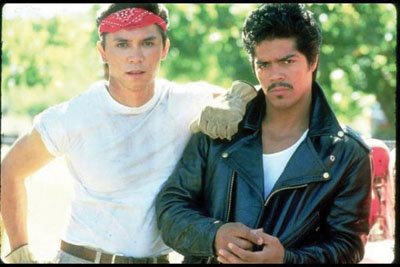Whenever I watch the opening credits of the 1987 movie
”
La Bamba,
”
I laugh at the little lie found in one quick shot. One of the
characters rolls along a hill-bound road on his Harley-Davidson
motorcycle. He passes a highway sign that reads
”
Pacheco Pass.
”
I grew up in Hollister so I know the sign is a touch of creative
license.
Whenever I watch the opening credits of the 1987 movie “La Bamba,” I laugh at the little lie found in one quick shot. One of the characters rolls along a hill-bound road on his Harley-Davidson motorcycle. He passes a highway sign that reads “Pacheco Pass.” I grew up in Hollister so I know the sign is a touch of creative license. This “Pacheco Pass” is actually Quien Sabe Ranch Road, a bucolic country lane that winds through the cow country heart of rural San Benito County.
There’s magic in movies. Every film is a series of conjuror’s tricks. These little deceptions create a story world that the filmmaker invites audience members to step into and explore for an hour or two and perhaps uncover some universal truths. We are induced by cinematic illusions to find for ourselves what really matters.
Film director Luis Valdez filmed many of the “La Bamba’s” early scenes among the farm fields of San Benito County: The migrant worker camp where men, women and children labor under a hot summer sun; The old Southside Elementary School with its art deco architecture; The hills blanketed with golden California grass bathed in a sunset glow. These locations provide a backdrop for a tale about a polite young teenager named Richie Valenzuela who is transformed into rock-and-roll legend Richie Valens.
I was a student at Gavilan Community College when Valdez was filming “La Bamba” in San Benito County. I remember the excited buzz in Hollister as citizens discussed the project. Everyone felt a glowing pride that a film about a music celebrity was being made in our very own region of California.
We didn’t know it at the time, but our community played a role in creating a film that’s now a part of cinematic history. “La Bamba” is the first Hollywood hit that tells the story of a Hispanic family. It grossed more than $54 million in theaters. More important than its commercial success, “La Bamba” built bridges across cultures through the art of cinematic story-telling. It touched the hearts of audiences in the United States and around the world because it poignantly paints a picture of the struggles of family life. The Valenzuelas dealt with the same challenges faced by families for countless generations. The financial struggles, the sibling rivalry, the tensions between people with different dreams – these themes explored in “La Bamba” connect us all in the human conflicts of a family.
Although it came out nearly a quarter of a century ago, “La Bamba” still resonates with a drama dealing with the same social issues we’re facing today. I see the movie as a metaphor of America. The film describes how people come to our land with dreams for a better life. They bring with them the best of their culture to offer as a kind of sacrifice to gain the American dream. In the assimilation process, America eventually absorbs their ethnic offerings into its own broader customs and traditions.
In “La Bamba,” the offering is the song the movie is titled after, a folk tune originating from the Mexican state of Veracruz that’s often sung at weddings. In 1958, Richie Valens repackaged this traditional song as fast-driving rock music. His hit rose in the top 40 charts. On some lists, it’s still considered one of the best 100 rock songs. Ironically, Valens did not speak Spanish, so he had to learn to sing the lyrics phonetically. Soon after its release, Americans were singing “La Bamba,” although most of them most likely didn’t know what exactly the catchy Spanish lyrics meant.
If you love the movie “La Bamba” and might like to hear how it came to be created, I encourage you to attend a special event the Poppy Jasper Film Festival will host on Nov. 13. At the “An Evening with Luis Valdez” gala at Live Oak High School in Morgan Hill, Valdez will discuss the art and craft of cinematic storytelling.
There’s a bit of an irony in the venue. Last May four Live Oak High School students wore American-flag T-shirts on Cinco de Mayo, setting off a firestorm when school administrators ordered them to either turn the shirts inside out or go home for the day. When newspapers, bloggers, and TV and radio reporters built the story into a national news event, the community of Morgan Hill found itself at the media epicenter of a heated discussion of what it means to be an American. Valdez’s film “La Bamba” addresses this very issue – but without creating intense controversy.
That’s the magic of movies like “La Bamba.” The cinematic arts let us step into a world where we can for a short spell live the life of other people. They connect us all in our common humanity through the power of story enchantment.
“An Evening with Luis Valdez” will take place at 5:30 p.m. Nov. 13 at Live Oak High School, 1505 East Main Ave. in Morgan Hill. Tickets costs $20 for adults and $10 for young people 18 years or younger. To purchase tickets visit www.poppyjasperfilmfest.org or call (408) 782-8087.












